Lewes: Difference between revisions
m →Name |
m clean up, typos fixed: Ebay → eBay, Lewes based → Lewes-based |
||
| Line 96: | Line 96: | ||
From 1794 beers, wines and spirits were distributed from Lewes under the ''Harveys'' name, and the town is today the site of Harvey & Son's brewery celebrated as one the finest ale producers in England. | From 1794 beers, wines and spirits were distributed from Lewes under the ''Harveys'' name, and the town is today the site of Harvey & Son's brewery celebrated as one the finest ale producers in England. | ||
In September 2008, Lewes launched its own currency, the Lewes Pound, in an effort to increase trade within the town. One Lewes Pound is equal to £1 and can be exchanged for the same amount of pounds sterling in several shops in Lewes and can be spent in a wide range of local businesses. Many of the notes were sold on | In September 2008, Lewes launched its own currency, the Lewes Pound, in an effort to increase trade within the town. One Lewes Pound is equal to £1 and can be exchanged for the same amount of pounds sterling in several shops in Lewes and can be spent in a wide range of local businesses. Many of the notes were sold on eBay at a higher amount. Early numbers and sequenced notes fetched very high prices from foreign collectors. | ||
==Landmarks== | ==Landmarks== | ||
| Line 141: | Line 141: | ||
Lewes has its own Restricted Service Licence radio station, Rocket FM,<ref>[http://www.rocketfm.org.uk/ Rocket FM]</ref> which broadcasts on FM and the Internet for three weeks in October/November each year, covering the Bonfire period. | Lewes has its own Restricted Service Licence radio station, Rocket FM,<ref>[http://www.rocketfm.org.uk/ Rocket FM]</ref> which broadcasts on FM and the Internet for three weeks in October/November each year, covering the Bonfire period. | ||
Radio Lewes http://www.radiolewes.org.uk a 24/7 internet based webcast station, is run by members of the Lewes based charity [http://en.wikipedia.org/w/index.php?title=The_Oyster_Project&oldid=547656909 The Oyster Project]<ref>[http://www.radiolewes.org.uk Radio Lewes]</ref> as well as promoting local musicians it also offers up-to-date news for the local community and particularly people with disabilities, the charity has been founded and is run by people with disabilities. | Radio Lewes http://www.radiolewes.org.uk a 24/7 internet based webcast station, is run by members of the Lewes-based charity [http://en.wikipedia.org/w/index.php?title=The_Oyster_Project&oldid=547656909 The Oyster Project]<ref>[http://www.radiolewes.org.uk Radio Lewes]</ref> as well as promoting local musicians it also offers up-to-date news for the local community and particularly people with disabilities, the charity has been founded and is run by people with disabilities. | ||
==Sport== | ==Sport== | ||
Latest revision as of 22:53, 28 January 2016
| Lewes | |
| Sussex | |
|---|---|
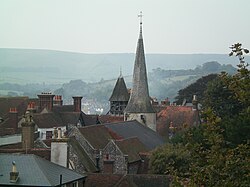 Lewes from Lewes Castle | |
| Location | |
| Grid reference: | TQ420104 |
| Location: | 50°52’32"N, -0°1’4"E |
| Data | |
| Population: | 16,222 (2007 est.) |
| Post town: | Lewes |
| Postcode: | BN7 |
| Dialling code: | 01273 |
| Local Government | |
| Council: | Lewes |
| Parliamentary constituency: |
Lewes |
| Website: | http://www.lewes-town.co.uk/ |
Lewes is a town in Sussex, an ancient bridging point and a market town, and today as a communications hub and tourist-oriented town. At the 2001 census it had a population of 15,988.[1]
Name
The name Lewes is the Old English Hlawas, which means "hills", perhaps refers to the hills of the South Downs or to ancient burial mounds in the area.
Geography
You can see Lewes lying like a box of toys under a great amphitheatre of chalk hills ... on the whole it is set down better than any town I have seen in England.—William Morris (1834-1896)
Lewes sits on the Greenwich Meridian, in a gap in the South Downs, cut through by the River Ouse, and near its meeting with the Winterbourne Stream. It is approximately seven miles north of Newhaven, and an equal distance north-east of Brighton. Where the Greenwich Meridian runs through the western part of Lewes was once a pub (now demolished) named after it.
The South Downs rise above the river on both banks. The High Street, and earliest settlement, occupies the west bank, climbing steeply up from the bridge taking its ancient route along the ridge; the summit on that side, 2.5 miles distant is known as Mount Harry. On the east bank there is a large chalk cliff Cliffe Hill that can be seen for many miles, part of the group of hills including Mount Caburn, Malling Down (where there are a few houses in a wooded area on the hillside, in a development known as Cuilfail) and Golf Hill (home to the Lewes Golf Club). The two banks of the river are joined by Willey's Bridge (a footbridge), the Phoenix Causeway (a recent concrete road bridge, named after the old Phoenix Ironworks) and Cliffe Bridge (an eighteenth-century replacement of the mediæval crossing, widened in the 1930s and now pedestrianised).
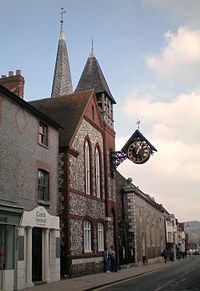
The High Street runs from Eastgate to West-Out, forming the spine of the ancient town. Cliffe Hill gives its name to the one-time village of Cliffe, now part of the town. The southern part of the town, Southover, came into being as a village adjacent to the Priory, south of the Winterbourne Stream. At the north of the town's original wall boundary is the St. John's or Pells area, home to several nineteenth-century streets and the Pells Pond. The Pells Pool, built in 1860, is the oldest freshwater lido in England. The Phoenix Industrial Estate lies along the west bank of the river. This area is home to the old fire station and subject of a potential regeneration project.
Malling lies to the east of the river and had eighteenth and nineteenth-century houses and two notable breweries. Road engineering and local planning policy in the 1970s cleared many older buildings here to allow the flow of traffic; it now goes along Little East Street, across the Phoenix Bridge and through the Cuilfail Tunnel to join the A27.
The town boundaries were enlarged twice (from the original town walls), in 1881 and 1934. They now include the more modern housing estates of Wallands, South Malling (the west part of which is a previously separate village with a church dedicated to St. Michael), Neville, Lansdown, and Cranedown on the Kingston Road.[2]
Countryside walks can be taken starting from several points in Lewes. One can walk over Mount Caburn to the village of Glynde starting in Cliffe, traverse the Lewes Brooks (an RSPB reserve) from Southover, walk to Kingston near Lewes also from Southover, or wander up along the Ouse to Hamsey Place from the Pells. The South Downs Way rises just below Lewes and hikers often stop off at the town.
Natural sites and events
Three Sites of Special Scientific Interest lie within the parish: Lewes Downs, Lewes Brooks and Southerham Works Pit. Lewes Downs is a site of biological interest, an isolated area of the South Downs.[3] Lewes Brooks, also of biological importance, is part of the floodplain of the River Ouse, providing a habitat for many invertebrates such as water beetles and snails.[4] Southerham Works Pit is of geological interest, a disused chalk pit displaying a wide variety of fossilised fish remains.[5]
The Railway Land nature reserve is on the east side of the town next to the Ouse, and contains an area of woodland and marshes known as the Heart of Reeds. The Winterbourne stream, a tributary of the Ouse, flows through it. This stream flows most winters and dries up in the summer, hence its name. It continues through Lewes going through the Grange Gardens and often travelling underground. The Heart of Reeds is popular with pond-dippers and walkers. A centre for the study of environmental change is due to be built at the entrance to the nature reserve.[6]
On 27 December 1836, an avalanche occurred in Lewes, the worst ever recorded in Britain. A large build-up of snow on the nearby cliff slipped down onto a row of cottages called Boulters Row (now part of South Street). About fifteen people were buried, and eight of these died. A pub in South Street is named The Snowdrop in memory of the event.
On 21 August 1864, Lewes suffered an earthquake shock measuring 3.1 on the Richter scale.
In October 2000 the town suffered major flooding during an intense period of severe weather throughout the United Kingdom. The commercial centre of the town and many residential areas were devastated. In a government report into the nationwide flooding, Lewes was officially noted the most severely affected location.[7] As a result of the devastation, the Lewes Flood Action group formed, to press for better flood protection measures.[8]
Churches
The town’s parish church is St Michael's, standing located at the top of the High Street. Like St Peter's in nearby Southease, it has a round tower, with a shingled spire. Its length runs along the street rather than away from it and the cemetery is separated from the High Street by stone walls with iron railings on top.
Next to the church is a building which is used upstairs as a Sunday School.
St Michael in South Malling was built in 1628. It is the parish church of South Malling and goers back to the days when South Malling was a village of its own, before suburbs engulfed it. The church mainatins its village setting by the River Ouse, and beside it is the rectory.
Churches of the town include:
- Church of England:
- St Michael's
- St. Anne's
- St John sub Castro (‘’St. John-under-the-Castle’’) the northernmost church in the old town.
- St Thomas à Becket (Cliffe)
- St Michael, South Malling
- ’’All Saints: deconsecrated and now a community arts space’’
- Free Presbyterian: The Jireh Chapel (Lewes Free Presbyterian Church)
- Eastgate Chapel
- Religious Society of Friends (Quakers) (1784)
- United Reformed Church and Methodist: Christ Church Hall
- Unitarian: Westgate Chapel (sixteenth-century)
- Roman Catholic: St Pancras
History
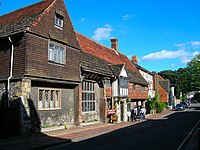
Scholars think that the Roman settlement of Mutuantonis was here, as quantities of artefacts have been discovered in the area. The Saxons built a fortress, having first constructed its motte as a defensive point over the river; they gave the town its name.[9]
After the Norman invasion, William the Conqueror rewarded William de Warenne, 1st Earl of Surrey with the Rape of Lewes, a swathe of land along the River Ouse from the coast to the Surrey boundary. He built Lewes Castle on the site of the English fortress; and he and his wife, Gundred also founded the Priory of St Pancras, a Cluniac monastic house, in about 1081. Lewes was the site of a mint during the Late Anglo-Saxon period and thereafter a mint during the early years after the Normans came. In 1148 the town was granted a charter by King Stephen. The town became a port with docks along the Ouse River.
The town was the site of the Battle of Lewes between the forces of Henry III and Simon de Monfort in the Second Barons' War in 1264, at the end of which de Monfort's forces were victorious. The battle took place in fields now just west of Landport.
At the time of the Marian Persecutions of 1555–1557, Lewes was the site of the execution of seventeen Protestant martyrs, who were burned at the stake in front of the Star Inn. This structure is now the Town Hall. Through the seventeenth and eighteenth centuries, Lewes developed as the county town of East Sussex, expanding beyond the line of the town wall. It was an active port and developed related iron, brewing and ship building industries.
In 1846 the town became a railway junction, with lines constructed from the north, south and east to two railway stations. The development of Newhaven ended Lewes's period as a major port. During the Crimean War, some 300 Finns serving in the Russian army captured at Bomarsund were imprisoned at Lewes. Lewes became a borough in 1881.
Lewes Bonfire
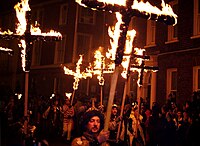
The town's most important annual event is the Lewes Bonfire celebrations on the 5th of November, Guy Fawkes Night. In Lewes this event not only marks the date of the uncovering of the Gunpowder Plot in 1605, but also commemorates the memory of the seventeen Protestant martyrs burnt at the stake for their faith during the Marian Persecutions. The celebrations, which involve burning an effigy of the Pope, are the largest and most famous bonfire night celebrations in the country.[10][11]
Economy
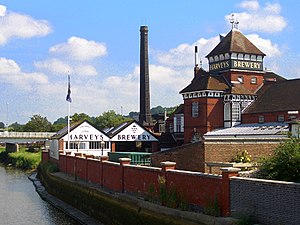
The Lewes Chamber of Commerce represents the traders and businesses of the town.[12] The town has been identified as unusually diversified with numerous specialist, independent retailers, counter to national trends toward 'chain' retailers and large corporate retail outlets.
Lewes Farmers' Market, one of the first in the UK, was started in the 1990s by Common Cause Co-operative Ltd[13] and is a very popular re-invention of Lewes as a market town. The Farmers' Market takes place in pedestrianised Cliffe High Street on the first Saturday of every month, with local food producers coming to sell their wares under covered market stalls. A weekly food market in the Lewes Market Tower was established in July 2010 by Transition Town Lewes to allow traders to sell local produce. Occasionally French traders attend, with stalls on Cliffe Bridge.
From 1794 beers, wines and spirits were distributed from Lewes under the Harveys name, and the town is today the site of Harvey & Son's brewery celebrated as one the finest ale producers in England.
In September 2008, Lewes launched its own currency, the Lewes Pound, in an effort to increase trade within the town. One Lewes Pound is equal to £1 and can be exchanged for the same amount of pounds sterling in several shops in Lewes and can be spent in a wide range of local businesses. Many of the notes were sold on eBay at a higher amount. Early numbers and sequenced notes fetched very high prices from foreign collectors.
Landmarks
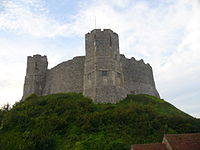
The town is the location of several significant historic buildings, including Lewes Castle, the remains of Lewes Priory, Bull House (the former home of Tom Paine), Southover Grange and public gardens, and a sixteenth-century timber-framed Wealden hall house known as Anne of Cleves House because it was given to her as part of her divorce settlement from Henry VIII, though she never lived there. Anne of Cleves House and the Castle are owned and maintained by the Sussex Archaeological Society (whose headquarters are in Lewes). The Round House, a secluded former windmill in Pipe Passage, was owned by the writer Virginia Woolf.
The steep and cobbled Keere Street is home to many historic buildings, including a timber framed antiquarian bookshop. The gardens of the buildings on the east side of the street border the old Town Walls. The Prince Regent once drove his carriage down the Street, and a sign at the bottom commemorates this event.
The ancient street pattern survives extensively as do a high proportion of the mediæval building plots and oak framed houses, albeit often masked with later facades. The eighteenth century frontages are notable and include several, like Bartholomew House at the Castle Gate, that are clad in mathematical tiles which mimic fine brick construction. Numerous streets of eighteenth and nineteenth century cottages have survived cycles of 'slum clearance' as models of attractive town housing.
At the highest point of the old town the Portland stone and Coade stone facade of the Crown Court (1808–12, by John Johnson), the brick Market Tower and florid War Memorial mark the historic centre, although trade has tended to concentrate on the lower land in modern times. At the lowest part of the town, by the river, Harvey & Son's Brewery, 'The Cathedral of Lewes' is an unspoilt nineteenth-century tower brewery and is the only one of the town's five original major breweries still in use. The railway station is the other important monument of the industrial era.
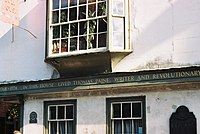
Southover Grange was built in the sixteenth century with Caen limestone taken from the ruins of Lewes Priory. The house and its gardens were bought by the borough council and opened to the public in 1945. It is used as a nursery school and as a venue for weddings and exhibitions. The north wing is home to Lewes Register Office, a craft shop and The Window café (open in spring and summer). The Grange gardens are divided by the Winterbourne stream and contain formal bedding displays, a wildflower area, a knot garden and some notable trees, including a large Magnolia grandiflora, a mulberry tree dating perhaps to the seventeenth century and a tulip tree planted by Queen Elizabeth II. The gardens are open to the public during daylight hours all year round.
Pelham House dates back to the sixteenth century and features architecture of all subsequent eras and a private landscaped garden facing the Downs. It now serves as an independent hotel. Shelleys Hotel is likewise of some antiquity with a private garden and family associations with Percy Shelley.
The centre of Lewes is notable for a consistently high calibre of regional vernacular architecture and variety of historic construction materials and techniques.
Culture
Four miles outside Lewes is Glyndebourne opera house. Founded in 1934, the venue draws large audiences for its Summer Festival and has attracted a host of international talent throughout its history.
A number of local classical music series operate in the town, including the Nicolas Yonge Society;[14] the Westgate Series based at the Westgate Chapel; and the baroque and early classical Workshop Series.[15] The Lewes Concert Orchestra[16] was founded in 1993.
The principal town museum is Barbican House Museum at Lewes Castle, which hosts the Lewes Town Model[17] as well as four galleries of Sussex archaeology. Anne of Cleves House has various collections relating to the history of Lewes.
There is also the Hop Gallery[18] in the former Star Brewery in Market Street; St Anne's Gallery[19] in the High Street and occasional art exhibitions mounted at the Town Hall. The Foundry Gallery[20] was converted by Artemis Arts from the former Market Lane Garage in 2006 for use for art events.
The Lewes Film Club, which also produces short films, and Film at All Saints (the Film Club in collaboration with Lewes Town Council), show films based in the All Saints Centre, a former church.
Popular music events take place at a number of venues and pubs across the town. A monthly comedy club based at the Con Club was created in 2010.
Annual arts events include ArtWave[21] and the children's Patina Moving On Parade.[22] An annual Lewes Guitar Festival which started in 1999 has not operated since the late 2000s.
The Headstrong Club[23] whose notable members include Thomas Paine was relaunched in 1987 and continues to operate.
Media
The Sussex Express newspaper, based in Lewes, was established in 1837 and serves much of Sussex.
Viva Lewes was founded as a weekly web magazine in January 2006 and also as a monthly print handbook in October 2006 covering events and activities in and around the Lewes area.[24]
Bright 106.4 FM radio station, based in Burgess Hill, broadcasts to an area which extends to Lewes.
Lewes has its own Restricted Service Licence radio station, Rocket FM,[25] which broadcasts on FM and the Internet for three weeks in October/November each year, covering the Bonfire period.
Radio Lewes http://www.radiolewes.org.uk a 24/7 internet based webcast station, is run by members of the Lewes-based charity The Oyster Project[26] as well as promoting local musicians it also offers up-to-date news for the local community and particularly people with disabilities, the charity has been founded and is run by people with disabilities.
Sport
- Athletics: Lewes Athletic Club
- Cricket: Lewes Priory Cricket Club
- Cycling: Lewes Wanderers Cycling Club
- Football: Lewes FC, founded in 1885
- Rugby: Lewes Rugby Football Club, founded in 1930
- Swimming: Lewes Swimming Club
Lewes Racecourse, immediately to the west of the town on the slopes of the Downs, operated for 200 years until closed in 1964. It is still used as a training course, and there are several stables nearby.[27] Race days are held at nearby Plumpton Race Course.
There are a number of Service Clubs in Lewes of which one is the Lewes Lions Club which is a member of Lions Clubs International, the largest Service Organisation in the world. The club runs various events including the Christmas Concert in December each year with the LGB Brass and the annual "International 'Toad-In-The-Hole' Competition" and holds street collections to raise funds so as to assist people and organisations in and around Lewes.
Lewes Tennis/Hockey Club (Southdown Sports Club). The club has 16 tennis courts, 4 squash courts, 2 netball courts and a floodlit astro/hockey pitch.
Outside links
| ("Wikimedia Commons" has material about Lewes) |
References
- ↑ Office for National Statistics : Census 2001 : Parish Headcounts : Lewes. Retrieved 2009-11-03.
- ↑ {{brithist|56908 "The borough of Lewes: Introduction and history"], A History of the County of Sussex: Volume 7 (1940), pp. 7-19, Accessed: 19 May 2008
- ↑ (PDF) SSSI Citation — Lewes Downs. Natural England. http://www.english-nature.org.uk/citation/citation_photo/1002952.pdf. Retrieved 2008-10-12.
- ↑ (PDF) SSSI Citation — Lewes Brooks. Natural England. http://www.english-nature.org.uk/citation/citation_photo/1003002.pdf. Retrieved 2008-10-12.
- ↑ (PDF) SSSI Citation — Southerham Works Pit. Natural England. http://www.english-nature.org.uk/citation/citation_photo/200061.pdf. Retrieved 2008-10-12.
- ↑ "''Railway Land Project''". Railwaylandproject.org. 2011-07-28. http://railwaylandproject.org/. Retrieved 2011-08-01.
- ↑ The flooded railway station featured on the cover of that week's Private Eye with the caption "Your Rains Tonight"
- ↑ "Lewes Flood Action Website". Lewes-flood-action.org.uk. http://www.lewes-flood-action.org.uk/. Retrieved 2011-08-01.
- ↑ Wilson, John Marius (1870-2). "Descriptive Gazetteer entry for Lewes". Imperial Gazetteer of England and Wales. Great Britain Historical GIS Project. http://www.visionofbritain.org.uk/descriptions/entry_page.jsp?text_id=739550&word=NULL. Retrieved 2008-09-21.
- ↑ Times Writers (November 5, 2009). "Tonight's the night: bonfires and fireworks". Times (London). http://women.timesonline.co.uk/tol/life_and_style/women/the_way_we_live/article6903456.ece.
- ↑ "Lewes Bonfire Council". Lewes Bonfire Council. http://www.lewesbonfirecouncil.org.uk/. Retrieved 2011-08-01.
- ↑ "Lewes Chamber of Commerce". Leweschamber.org.uk. http://www.leweschamber.org.uk/. Retrieved 2011-08-01.
- ↑ "Common Cause Cooperative". Commoncause.org.uk. http://www.commoncause.org.uk. Retrieved 2011-08-01.
- ↑ "Nicolas Yonge Society". Nyslewes.org.uk. http://www.nyslewes.org.uk/. Retrieved 2011-08-01.
- ↑ "Workshop Series". Workshop Series. http://www.theworkshopseries.co.uk/. Retrieved 2011-08-01.
- ↑ "Lewes Concert Orchestra". http://www.lewesco.org.uk/Index.htm/. Retrieved 2011-08-01.
- ↑ "Lewes Town Model". Lewes Town Model. http://www.lewestownmodel.co.uk/. Retrieved 2011-08-01.
- ↑ Hop Gallery
- ↑ St Anne's Galleries
- ↑ Foundry Gallery
- ↑ ArtWave Festival
- ↑ Patina Parade
- ↑ Headstrong Club
- ↑ Viva Lewes
- ↑ Rocket FM
- ↑ Radio Lewes
- ↑ Lewes Racecourse

